
| Main | Neocene |

What if small animals and plants would really become greater? And large ones – even larger?
Text by Igor Kraj
(article is published here in authorial version with pictures sent by author
himself; the magazine version can be seen here)
When they reached the glade, they flew
Straight towards the ocean blue;
There, across it, lay the whale-
Monster head and monster tail;
He was all one mass of holes,
From his ribs grew stakes and poles;
On his tail-a forest black;
And a village on his back;
Pyotr Yershov “The Little Humpbacked Horse”.
The great body of literature
is peppered with the idea of increase of arthropods up to huge size. Starting
from immortal Korney Chukovsky’s “Cock-the-Roach” poem, via Colin Wilson’s
“Spider World” and also terrible monster collections of D&D, and finishing
with recent Andrzej Sapkowski’s “The Witcher”, in which each third monster
has an external skeleton. |
|
|
Strugatsky brothers also had not forgot to populate Pandoran jungle with spiteful crayspiders. And Tolkien also did not stay by, having invented Shelob. Not trifling with the truth, it is possible to say, that where the fantasy is, giant arachnids are also. Or eagles. Or rats. Or all at once. What if small animals and plants would really become large? And large ones – even greater?
|
|
Giant spiders represent the most usual, classical
spawn of author’s imagination. Disgust to arachnids, frequently poisonous, had
been acquired by human ancestors as early as on trees. In addition arthropods
are alien to us like natives from another planet may be alien only. Inside out
creatures: at vertebrates body includes skeleton and the blood circulating in
tubes – arteries and veins. At arthropods skeleton is from outside, body is
a blood-filled vessel in which organs waver, and in tubes – tracheas – air moves.
Eight-eyed spider already looks scary, and being inflated up to the size of
pig, it becomes an embodiment of horror.
But arthropods are small, because their anatomy hinds growth. The largest creatures
of this kind are fossil eurypterid 2.5 meters long (3.4 meters with the pincers
extended forward), and the modern deep-water Japanese spider crab reaching 3.7
meters in leg span. On land only the millipede of Carboniferous had length of
three meters, but all the same it was more lightweight than contemporary coconut
crab. The nut-loving crustacean weighs as much as four kilograms. It is not
too much by the standards of vertebrates.
Even if to neglect natural restrictions, the world full of huge insects will
appears not so terrible. Of course, crow-sized mosquitoes fairly can taint pleasure
from walk. But deafeningly buzzing monster will hardly probably manage to sting.
From the point of view of an insect, which hadn’t got sharper sight, but lost
its maneuverability, human will turn to a target difficult to hit. And the mosquito
itself will be very vulnerable to the enemy.
Blood-suckers prefer their attacks to remain unnoticed. Predators are another
matter. In aeschna against which the witcher Geralt had to combat, and in kikimores
from Sapkowsky’s books increased one hundred times dragonfly nymph – the terrible,
ruthless hunter tearing its prey with serrated pincers – is easily recognized.
Of course, it is better to not come into the water in places where aeschna settles…
But where such monster may be met? Logically, crocodile-sized aeschna should
also settle in places where the crocodile may feed itself. In the rivers and
lakes of Europe there are no conditions for residing of so large predators.
In tropics there will be also true crocodiles. And, perhaps, the reptile, being
sharper and surpassing the competitor in acuteness of the senses, will not yield
to any insect nymph, even to one grown up a lot.
On the other hand, bugs and spiders know numerous dodges. For example, the insidious
ant-lion holed up at the bottom of sandy funnel will represent serious threat.
Though only for giant ants. Any self-respecting rabbit would not fall into such
trap.
Difficulties will arise also at huge spider. It will be very noticeable and
will lose the slightest chance to find out its prey earlier, than it will find
him out. Because dragonfly has 30 000 ommatidia each giving one “pixel” of the
image, gathered in two compound “batteries”; ant has a hundred of them only,
and at a spider only from two to eight, though very large and light-sensitive.
The resolution of eight pixels permits it to mark only a movement of large (in
spider’s measures) object in immediate proximity. Hearing organs at arachnids
are absent at all! Of course, eight-legged fright feels vibration when its body
hanging between legs begins shaking. But the giant form will feel only an earthquake.
Presenting huge arthropods to the
world, sci-fi writers suppose invariably two broadnesses. First, for an
animal all advantages of the initial tiny form – quickness, sometimes
even ability to flight – are kept. Although actually the giant could not
neither move nor breathe. Second, the “inflated” spider gets advantages
of vertebrates: keen sight and hearing, and frequently high intelligence
also. |
In real life deaf, blind and sluggish monster
will come to develop very refined hunting technique. For example, in dark caves
it can catch bats in its snare. Because the sonar of chiropterans does not detect
a string as thick as hair. Down covering body and legs, may transform into “invisible”
creature the spider itself. On the surface monster will have to keep in hole
in daytime and to arrange the trapping nooses hidden in grass at night.
Gigantism of insects also will not bring benefit to humans. To increase honey
gathering not large bees, but large flowers are required. Of course, giant silkworm
will give a string as thick, as fishing line, but the advantage of silk is in
its thinness.
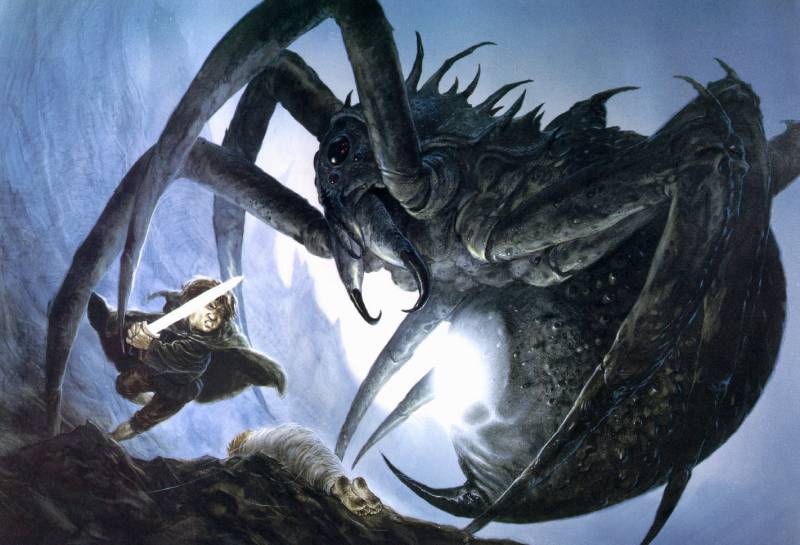
Cuticle of spiders is softer than covers of insects and much
softer than of
crustaceans. It will not be an essential obstacle for sharp steel.
From among land-dwelling creatures reptiles
of Jurassic and Cretaceous reached the greatest sizes. The record belongs, probably,
to Seismosaurus (36 meters, 40 tons). Compared to it monstrous Tyrannosaurus,
weighing seven tons only and even larger Spinosaurus and the crocodile
Deinosuchus (both 16 meters and 8 tons) look like pygmies.
No wonder, that reptiles are most naturally looked in the role of enormous monsters.
Some time ago the Earth rested on three elephants standing on back of giant
turtle. The mythology, both ancient and modern, is full of dragons. And Godzilla
looks more convincing, than King Kong.

The fact that Godzilla and King Kong can increase or decrease
three times
(the first one from 50 to 150 meters, the second one from 10 to 30 meters)
at will suggests about an illusory, non-material nature of these monsters in
focus. Their invulnerability is explained by it also.
Of course, in hard in all senses case of reptile of 50 meters in height (the estimated weight 4000 tons) it should be spoken neither about ecological expediency, nor simply about a physical opportunity of its existence. But what “if”? Hardly probably the giant reptile will attack people intentionally, but, simply walking through the populated areas, the monster can cause many troubles. The Japanese researchers, having worked this question, offer some methods, among which, however, only one is effective: to wait while the monster will move out itself. In real life orthograde Godzillasaurus will represent very easy aim for the tank fire. And though the armor-piercing shell flied from the distance of five-six kilometers for this monster is like rifle bullet for the elephant, but one bullet is enough for the elephant. As a last resort, it will be possible to shoot some more times. Godzilla’s “plasm gun” is effective only at the distance of one hundred meters.
Failures of the Japan Self-Defense
Forces take place because Godzilla is not a creature of flesh and blood,
but a personification of tsunamis or earthquakes – destructive disasters
often in this country, which are impossible to resist. Until the reptile
thinks using its second brain located in the base of tail, it is invincible.
Because it is impossible to explain to it, that situation is not so ridiculous
now, and it is a proper time to die, at last. |
While “designing” the giant monster, it is
necessary to refuse stereotypes. Because legs will not sustain body weight,
it is necessary to do without them. Snakes do it. Let the colossus creeps on
its belly, “making steps” on ribs. Long extended body stretched on the ground
will diminish the loading on the skeleton. In general, also a question of feeding
has a solution. Many animals are able to digest wood. The snake 70-80 meters
long will graze peacefully in forest, pulling out and swallowing the trees entirely.
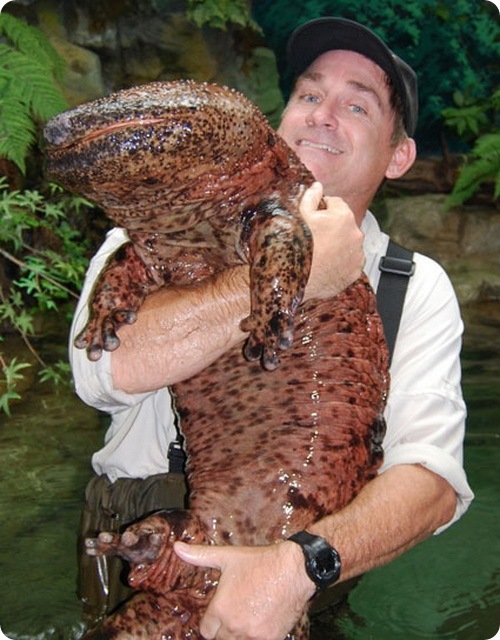
We have got used to think of tritons as of tiny creatures.
But giant salamander Andrias japonicus reaches the length
of 160 cm and weight of 180 kg.
|
The hippopotamus-sized toad can’t jump, but the ability of “shooting” its tongue is remained at this one. As against the crocodile, the amphibian will drag off its prey right from the coast, and then not to sink and tear it, but to swallow immediately, that is, undoubtedly, more convenient (it is not necessary to share prey with colleagues). It is necessary only to provide the mechanism interfering to large prey simply to pull out the tongue hooked it. In this regard the paralyzing by electric charge looks most organically. Shocker would be useful to a toad also for self-defense in water.
The aquatic habit of life removes restrictions
on the size. Even Sinbad the Sailor met a monster looking like island. Vikings
named such monsters as krakens.
How huge may sea creature be? The size is limited by resources accessible. Because
with each its doubling of size weight will increase in eight times, need for
food in six-seven times, and ability to get food depends on circumstances.
The record is held by plankton-feeding blue whale growing up to 33-39 meters
and up to 150, and according to some data even to 200 tons. Predators are smaller.
The length of the largest mosasaurs, ichthyosaurs, pliosaurs, extinct Megalodon
shark, and also predatory cetaceans – fossil Basilosaurus and modern sperm whale,
makes “only” from 20 to 25 meters. Though, the eel-looking dragon up to 40-50
meters long would not be surprising also. Due to narrow snake-like body it would
go into an allowable weight.
Key to gigantism is profitability. The creature not applying efforts for getting
food, and even for breath, presumes itself to be as huge as it wants. In reality
kraken similar to island would represent something like drifting float behind
which long networks of prey-catching tentacles trail. But such monster would
finish their life at the surf line within some years.
If to abstract from realities of our world, the 300-meter whale would become
magnificent lure for tourists. The most majestic natural phenomena would fade
at the background of the enormous body sliding in thickness of waters, a tail
raised to the height of the largest cathedrals, a fountain which does not yield
to the most powerful geysers. Hardly probable such creature would be considered
as an object of hunting. By the time, when people would receive the weapon capable
to kill the giant whale (we may speak only about special torpedoes or air bombs),
blubber would already lose the status of valuable resource. But in case of natural
death of Leviathan the 100 000 ton carcass decomposing at the coastal shallows
would turn to a problem of national scale.
The 200 meters long sea dragon, or the monstrous octopus capable to entangle
with its tentacles and to drag the ship to the sea bottom, may complicate navigation
only theoretically. But what is their profit from it? A vessel built of wood
or iron is inedible. People on it represent too insignificant prey for the monster.
It is too troublesome from the point of view of such giant to carve out tiny
biped pieces of meat from cabins, or to catch them one by one in water.
The idea of building of the settlement on back of swimming monster cannot be
named good. In fairy tales, anyway, it always happens badly. The endless cruise
– in direction known only to a monster – is, certainly, very romantic. But there
are no sources of fresh water on huge carapace.
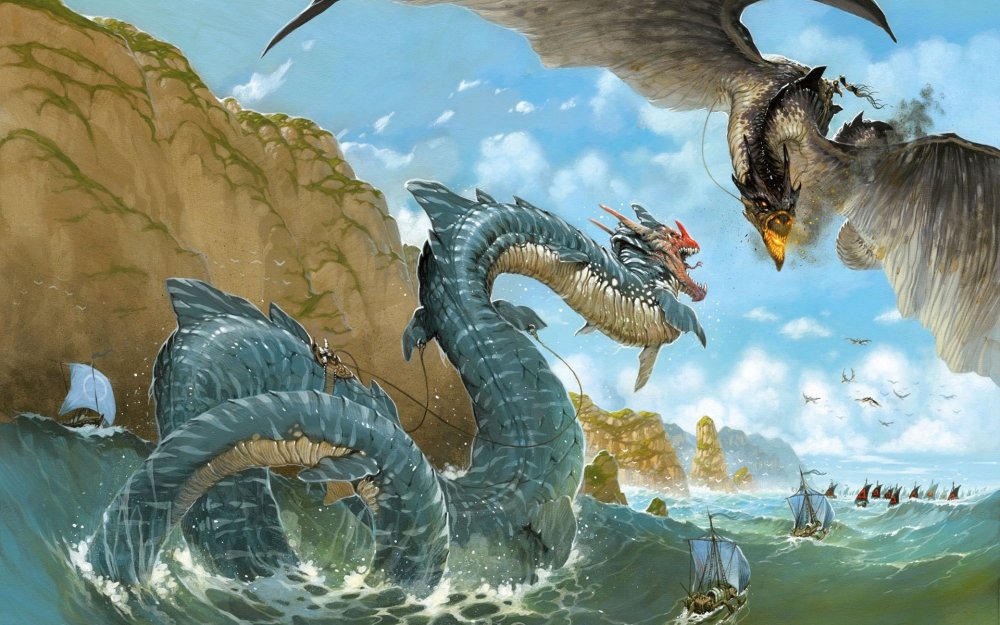
Use of sea dragons as military animals seems to be a good idea.
If not to think about how much forage is required for monsters.
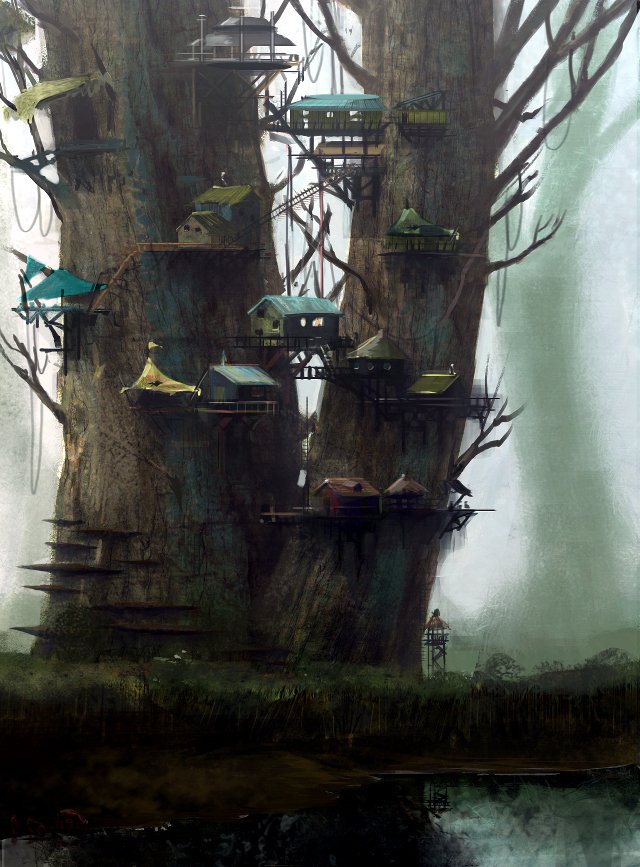
The weak spot of the concept of “supertree”: the 300-meter tall
forest
will receive the equal amount of water, sun and phosphorus from
the ground to 30-meter tall one. Well, what is the sense?
At the present moment 113-meter tall Sequoia
is considered as the tallest tree of the planet. Messages about 120-, 150- and
even 185-meter tall Australian eucalypts cause doubts. They are based mainly
on the circumstance that there is only one tree in focus. It does not happen
so. Plants compete with each other, aspiring to lift their crowns and “to take
the sun away” from contenders. But they do not aspire to raise above the grove
appreciably, becoming a target for lightnings and hurricanes.
As a part of a grove any tree will also not grow endlessly. It is so because
the stock of mineral substances at the area covered by roots is gradually depleted.
The ground of very old forest is very poor. Frequently only mosses, mushrooms
and lichens are capable to settle on it. Plant can’t expand its “plot”, because
the area around of it is occupied.
But what if by way of mental experiment we’ll neglect the restrictions put by
expediency and deficiency of resources? In durability to weight ratio good wood
does not yield to some bad steel. At height of 300, or maybe, even 400 meters
the trunk will still maintain its own weight. Ideally, “super-tree” should represent
an openwork construction of the plaited branches raised on wide arch. The tree
equal to Tour d’Eiffel in height will be similar also to this construction in
its shape and design.
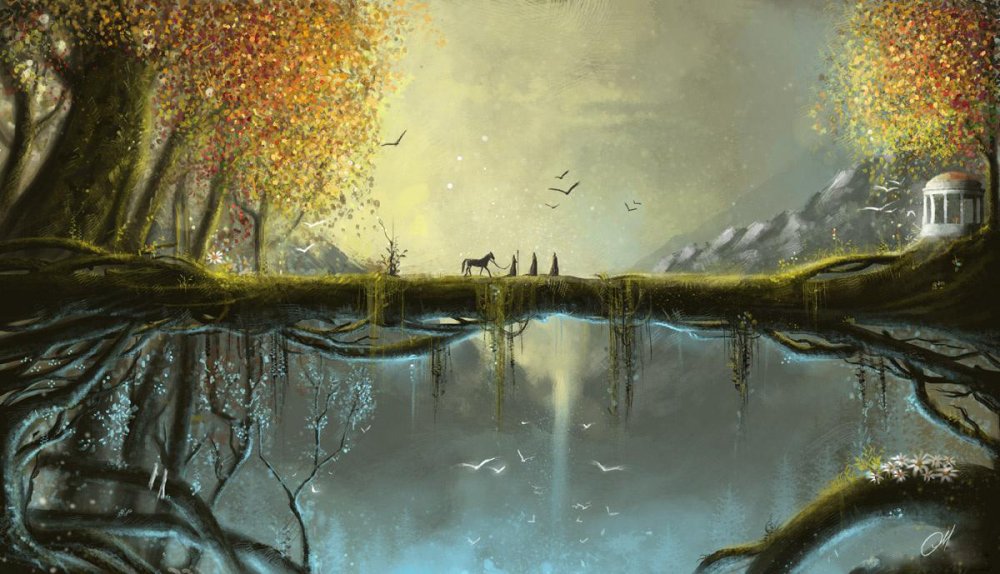
The “horizontal” root-like supertree needs the ability
to cross the rivers, forming arches above the current.
More probably, not a single plant, but a colony of trees not reaching to the sun racing each other, but plaiting their trunks and assisting each other, may have such design. And if so, can we admit one more form of “cooperation”? Branches, being flexible and thin like twine, are swooped by wind, entangle other trunks, and already then, having weighed down, grow thicker, covering intervals between “trees d’Eiffel” and giving a support to their leaves. Because such plant will fail to create a worthy crone in other way. Horizontally extended branches proportional to tree trunk will collapse under their weight.
Everything becomes much easier if
to place a trunk to horizontal position. Or to provide it with any additional
support, at least as buoyant force. On land the rattan liana reaches the
length of 200-300 meters. In the sea the absolute record belongs to Posidonia
sea plant. One specimen taken from the bottom of Mediterranean Sea (about
100 000 years old) was extended more than to eight kilometers. |
If we’ll imagine “super-tree” not as a vertical
trunk, but as a root laying in the ground, nothing prevents to surround with
it even the whole continent. Such a “decision” contains even a hint to expediency.
“Worldwide” tree is resistant to forest fires. Trunks and crones will burn down
only, and it will take a short time to restore them due to the nutrients stored
in roots. Droughts are not a problem. Its branches may turn green above the
desert, while roots pump water from the far rivers and wetlands.
But the wood monster will look not so impressively: enormous bank reaching from
horizon to horizon and surrounded with a lifeless exclusion area (because near
the main root the ground is exempted from everything useful in the slightest
degree for a long time) and walls of bush rising at borders of this zone. But
a positive influence of the giant to ecology will be great. In fact, the tree
can make land improvement by draining wetlands – potential sources of fertilizers
– and by redistributing water and mineral substances. It would be able to fulfill
even arrogant projects, which usual plants, having limited resources, do not
undertake. In deserts its roots can reach deep water-bearing layers, and vertical
shoots of its trunk will stop barchans.
Of course, vertical “forest d’Eiffel” is less pragmatic. It rather has aesthetic
value. Live skyscrapers connected by several levels of lianas represent the
special world in which everything noteworthy is located high above the ground.
Below, among the bent, overwound supports hardened under monstrous weight, each
of which is thicker than redwood trunk, neither herbivores, not predators will
be present – only fungi and insects processing fallen foliage. Accordingly,
also people, if they will wish to live in such strange place, hunting birds
and arboreal beasts, will have to rise to crowns. And there they’ll need to
build any habitation, because it is not rationally to climb a great height each
day. Among twisted trunks clambering up each other there will be enough places
for platforms to build houses. Lumber for building and fuel for hearth will
also be present.
The increase of the size of arthropods is interfered by technical decisions out-of-dated as far as 300 million years ago. The external shell skeleton is unfairly heavy, legs located on sides of the body do not give a reliable support, and the tracheal system of breath is insufficiently effective. But the last problem is solved in general by some spiders and decapod crustaceans had acquired true lungs. As for an armor and “lateral” legs, turtles have a similar anatomy. Meanwhile, rather recently extinct Australian horned tortoise Meiolania reached the length of five meters and weight of two tons.
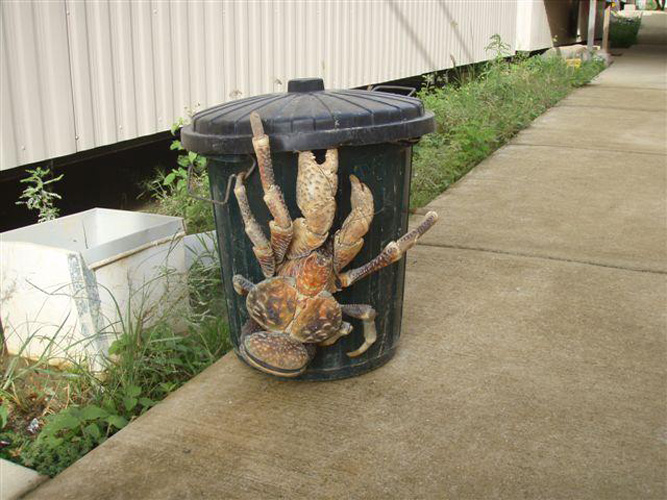
Coconut crab Birgus latro is not only the largest arthropod
ever lived
on land, but also one having the most perfect breath organs.
But all the same, arthropods are not reptiles. Even if we’ll take for a basis the best of the samples created by a nature – a coconut crab – it is possible to imagine, at least, three-meter long land-dwelling crustacean waddling hardly on short powerful legs. Of course, the monster will be frightening externally, but strictly herbivorous.
Having brought the idea of gigantism up to
its logical conclusion, we shall get a creature of planetary scale. Similar
to intellectual ocean of Solaris planet from Stanislav Lem’s great novel. The
occurrence of a miracle like that in the galaxy does not seem to be so impossible.
It is quite possible to imagine a colossal cell filled the ocean with itself
and transformed its waters to the cytoplasm.
Nevertheless, questions still remain. The united and immortal creature is not
capable to arise in the evolutional way, because all improvements in biosphere
take place by means of natural selection. It is not clear, for solving of what
tasks it was required to Solaris to get intelligence. The liquid thinker leads
quite vegetative habit of life: just acquire radiation of a star and dissolve
minerals from a planetary crust.
Besides if Solaris is similar to a human brain, any of its thoughts should represent
an exchange of signals between the sites thousands of kilometers away from each
other. Simply to notice a rigid radiation from the station soaring above its
waves, it would took this ocean… three months.
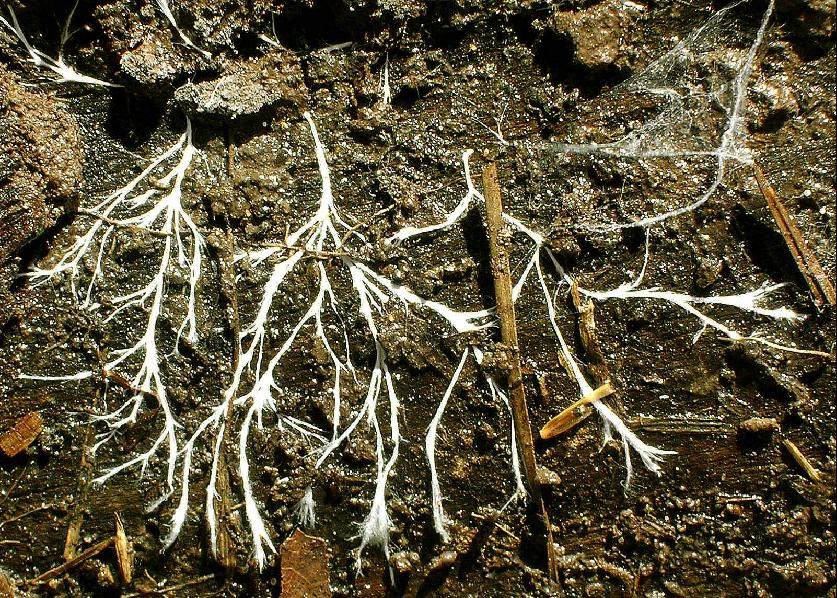
The overall extent of strings of the most ordinary
mycelium may reach 8 000 kilometers.
***
Though it seems that in the past everything
had been larger – even ferns shot up to 30 meters height – almost all absolute
records of the live world belong to the modern epoch. The largest animal is
a blue whale. The mightiest predator is a sperm whale – in dinosaur epoch nobody
could be compared to it. The longest creature is a nemertean worm. The highest
tree from among ever existed ones is Sequoia.
The size makes a lot of inconveniences to colossuses. But gigantism as a strategy
of the adaptation remained actual in every epoch. It is important for plants
to overgrow their competitors, blocking the sunlight to them. Predators prefer
not to have a deal with animals larger than they are. If you managed to become
so large that it appeared not favorable to your natural enemies to become even
larger, your safety is guaranteed.
In each new geological epoch animals and plants are improved and solve better
the problems produced by their own dimensions. Ferns had been great once – great
for ferns. But they could not reach the same height, as coniferous trees could.
Further reading
Stanislav Lem “Solaris”
Andrzej Sapkowski „The Witcher”
Arcady and Boris Strugatsky “Beetle in the Anthill”
John R. R. Tolkien “The Lord of the Rings”
Colin Wilson “Spider World. The Desert”Further watching
“Godzilla” (1984)
“King Kong” (2005)
* Phrase from the poem "Cock-the-roach" by Soviet poet Kornei Chukovsky.